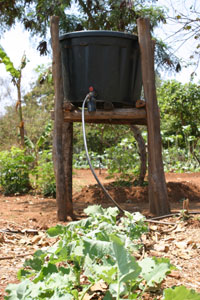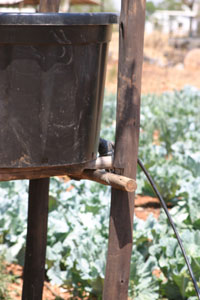Techniques : Drip Irrigation Garden 100m2
What is it?
 This is a method of applying small drops of water to the soil through specialized drip systems that have been designed to release these small quantities of water to the soil.
This is a method of applying small drops of water to the soil through specialized drip systems that have been designed to release these small quantities of water to the soil.
What equipment is involved?
The equipment consists of a water tank, tap, filter, main and lateral pipes and drip emitters. The emitters are placed at 30cm intervals along the lateral pipes that are responsible in carrying the water from the tank to the crop. Once the water is released, the emitters slowly release the water into the soil drop by drop.How big is the garden?
The Drip Kit can cover 100m2 and the pipes are placed 10 meters wide and 10 meters long. These are joined together by means of connectors, which are part of the Kit.How does it work?
The tank of between 100 to 200 litres is mounted about 1 metre above the ground so that the system has enough pressure to drive the water through the system. This means that no electricity or pumps are necessary to move the water, making the system cheap to use. The tank is filled with clean water and 200 litres of water are applied per irrigation cycle, depending on the conditions prevailing. Once the water reaches the emitters it is released into the soil drop by drop. This slow release allows all the water to enter the soil with minimal runoff. By the end of the irrigation, the soil is wetted continuously along the line of each lateral pipe, as well as up to 15 to 20 cm on either each side.Who can use these kits?
Kits can be used by all engaged in small to medium sized vegetable production. Due to its labour and water saving characteristics it is suitable for all ages. It is particularly good for persons recuperating from illness as the exercise is mild and the effects of working in the open air increase the rate of recovery.What are the advantages?
 The kit uses 50% less water than conventional gardens and using mulch can further increase this saving.
The kit uses 50% less water than conventional gardens and using mulch can further increase this saving.
The labour demands are reduced by as much as 50% mainly due the reduced watering requirements as well as the reduced need for weeding as the water is only applied to the area covered by the crop.
The kit allows one to:
- grow household food;
- improve nutrition at household level;
- improve household income through the sale of excess produce; and
- increase the availability of vegetables in the community.
Farmers have the potential to make more than half a ton of vegetables a year, depending on the crop mix and the intensity of production.
How often should I irrigate and how will I know the crop has adequate water?
In order to decide when to irrigate, the crop and soil condition should be assessed prior to irrigation. Soil moisture level should be assessed by digging and examining the water content. Also the condition of the crop can also be used as well to determine when to irrigate. Normally 200 liters of water applied every 24 to 48 hours would be adequate. However this depends on the time of year and what other water management options are in place. The use of mulch will reduce the amount of water lost and thus the intervals between irrigations can be reduced. In winter and overcast days the rate of water loss from the soil is reduced and thus the interval between irrigations can also be increased. A 200-liter container takes about 45 minutes to be emptied under normal circumstances.What crops can be grown?
Almost all commonly grown crops can be grown but changes have to be made to the spacings so as to fit into the wetting pattern of the drip. Some examples are:
butternut, beetroot, cabbages, carrots, chilies, chomoullier, gem squash,
green beans, maize, onions, pumpkins, rape, shallots, spinach, squash, tomatoes.
green beans, maize, onions, pumpkins, rape, shallots, spinach, squash, tomatoes.
How much will it cost to install a kit?
| FULL KIT WITH 85 LITRE CONTAINER | |
|---|---|
| 100 m2 plastro Drip Kit | price on application |
| 1 x 85 liter container | price on application |
| Total Cost: | price on application |
What training do I require?
Training will be required for kit installation, which can be done on collection of the kit. A simple manual on kit installation will be provided.Agronomic training can also be arranged for a group of farmers who are gathered at one central point. This is not included in the package but a separate charge will be levied for this. A quote will be provided on request.
